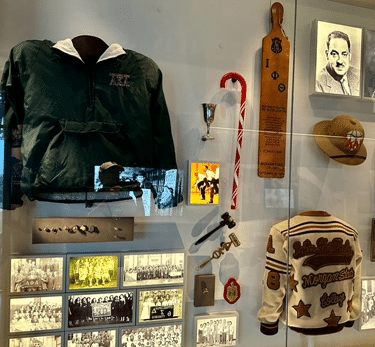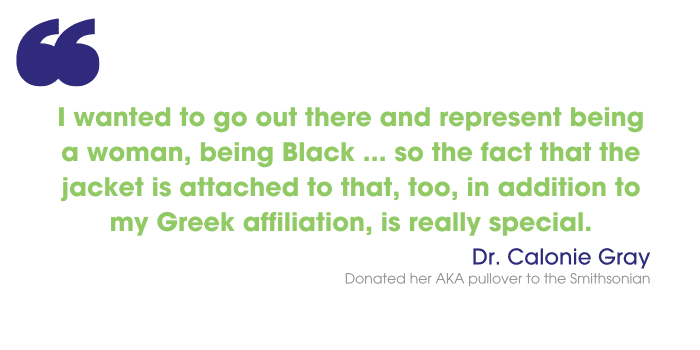The promotional products business is all about creating branded items and apparel that people will find meaningful and use to express themselves. This story is about one branded piece that found its way into history.
Spotted In The Smithsonian
Last September, Barry Lipsett visited Washington, D.C., including a tour of the Smithsonian’s National Museum of African American History and Culture. Turning a corner, Lipsett, the CEO of Boston-based supplier Charles River Apparel (PPAI 111644, Gold) saw a familiar jacket in a display on fraternities and sororities.
“I’m like, ‘Oh my God, I think that’s our jacket,’” he says. “I looked at it again, and I did see our logo on it, so I identified it was our jacket, and I was all excited.”
The item was indeed a Charles River classic solid pullover in forest green, decorated with pink embroidery for Alpha Kappa Alpha, the oldest African American collegiate sorority.
“That is our longest-tenured style in our line. It’s been in our line for over 30 years now, and it’s one of our most timeless pieces,” says Jason Lipsett, vice president of strategic initiatives and the third generation in the family-owned business, named the No. 37 supplier in this year’s PPAI 100.
Becoming A Piece Of History
Dr. Calonie Gray, the jacket’s original owner, had just moved to D.C. to work as a research analyst with a federal agency in late 2016. She was excited to participate in the Women’s March on January 21, 2017, and thought her AKA pullover – a gift from her mother – would be the perfect outer layer for the day’s weather, as well as to represent several facets of her identity.
“I thought it would be a great opportunity to showcase my heritage and this sorority and also be able to stuff my hands in a nice warm jacket,” she says.
Gray hosted a sign-making party before the march and invited her neighbors, one of whom worked with the Smithsonian in the curation department. That person later asked if Gray would be willing to donate what she wore at the march to the National Museum of African American History and Culture. Although she’d been fond of the pullover since her mom gave it to her in 1997, Gray says it was easy to say yes.
“I am so proud of the museum,” she says. “If it had been another organization or for another reason, probably [it would have been harder]. But it was easy. I was so excited about the museum – I was donating to the museum before I even saw it.”
Gray didn’t know the jacket had gone on display until someone else visited the museum and told her it was a part of the Greek Life section. She’s says it’s exciting to be part of history.
“I was not even here when it opened, but I was just excited to finally get tickets to go, so then to find out that I’m part of that in a different way is beyond words,” Gray says. “I don’t know how long that exhibit will last or [if] they’ll keep my jacket and not someone else’s, but it’s very touching. I’ve never gone to see it and not cried.”
She also took her mom to see the museum and the exhibit featuring the pullover she gave her daughter all those years ago.
“I wanted her to see it as well,” Gray says. “… It became special, because I was like, ‘Yeah, you were actually represented in the museum [because] I wore the jacket you gave me and the head scarf that you gave me,’ so she was really excited.”

IMAGE: Barry Lipsett
A Longtime Favorite
Gray says she has other AKA jackets, but she especially liked that pullover because it was lined and had a hood. In fact, she wore it so much that the zipper was broken. “I guess they pinned it together to make it look nice in the museum, but the zipper had been broken,” she says. “It was my favorite for colder days.”
The Lipsetts credit the staying power of their pullover in part to that lining, the brainchild of a longtime former sales rep with the company.
“He had the idea of adding a cotton lining to a windbreaker, and that’s how we came up with that style,” says Barry Lipsett, “… It’s kind of the go-to style in the Greek market. It’s a layering piece, and it also folds up into itself, so it’s easy to pack.”
Wearing Your Identity On Your Sleeve
Many items in the Smithsonian’s collections and on display at its 19 museums could be classified as promo products, but those pieces – from ephemera like campaign buttons to well-loved apparel like Gray’s AKA pullover – can tell us something about people and the times they lived in.

Although the jacket isn’t part of an exhibit on the Women’s March itself, the placard next to it on the wall does note that it was worn at the event, which Gray describes as “such a wild day.” She says wearing the AKA jacket helped her feel that she was literally wearing her identity on her sleeve among the crowd.
“I wanted to go out there and represent being a woman, being Black, being someone who believes in science, just to be a part of that,” she says, “so the fact that the jacket is attached to that, too, in addition to my Greek affiliation, is really special.”
The National Museum of African American History and Culture was created by an act of Congress in 2003 and opened its doors on the National Mall in 2016. It’s open daily to the public, and free, timed passes are required for entry.
The museum launched a Juneteenth Commemorative Collection in May that includes a variety of apparel, hats, tote bags, drinkware and more featuring designs by Black creators. The collection is part of a larger effort to celebrate the holiday commemorating the abolition of slavery in the U.S., declared a federal holiday in 2021, that also includes a curated summer reading list and virtual programming.

IMAGE: NMAAHCstore.com


